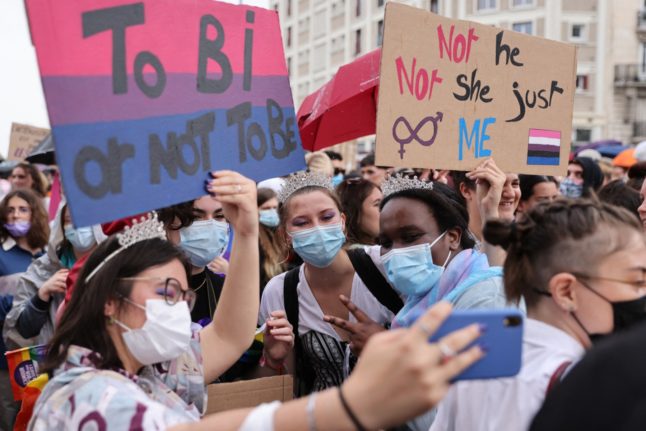French does, however, contend with additional grammatical challenges because the language itself is gendered.
It’s much less common to see people list their pronouns in the bios of social media accounts in France – although this may have to do with gendered French language. For example, people indicate their gender if they refer to themselves as a chercheur (researcher, masculine) or chercheuse (researcher, feminine)
In the US and the UK, it has become a mark of allyship with members of the LGBT community to add one’s pronouns, even if they have never changed, to email signatures or social media bios, but is not common practice in France.
That being said, people in France do change their pronouns – namely transgender people when changing their civil status on official documents. In social situations, anyone can specify the pronouns they wish to be used.
In France, the process to be legally recognised as the opposite sex must involve an application submitted to a court, and the applicant must be an adult or emancipated minor.
The person must demonstrate that the gender listed in their identification documents (ie birth or marriage certificates) does not match the gender they identify with – this might be done via testimony from friends and family, or even photos.
Since 2016, it has no longer been required to reference any ongoing or past medical treatment.
Gender-neutral
In parts of the English-speaking world, the use of the gender neutral pronoun ‘they’ is becoming more common, particularly among members of the LGBT community and people who identify as non-binary.
As of 2021, about a quarter (26 percent) of Americans said they knew someone who prefers gender-neutral pronouns (such as “they” instead of “he” or “she”). In the UK, a recent study found that nearly a quarter of people aged 26 and under identify using a non-gendered pronoun like ‘they/them’.
When it comes to France, a gender neutral pronoun does exist: iel, a mix between il (he) and elle (she).
In 2021, it was added to the dictionary Le Robert, which sparked backlash from right-wing politicians and members of the Académie Française, the historic body that concerns itself with matters of the French language.
In terms of its daily usage, iel is still far from mainstream, though it remains unclear exactly how many French people use the pronoun to describe themselves.
A recent study referenced in TETU magazine found that about two percent of people in France identified as non-binary and 24 percent of people said they knew someone who was.
Another poll, conducted in 2018 by French media 20 minutes, found that 13 percent of 18 to 30-year-olds in France did not identify as either a woman or a man. A separate IFOP survey published in Marianne in 2020 found that the true number might be closer to 22 percent.
One user of the iel, 23-year-old, Alex, explained to Le Parisien the personal importance of the pronoun: “I prefer to be referred to using the pronoun iel. It’s a complex feeling, which is linked to the way that you perceive yourself and how others perceive you.”
Alex told Le Parisien that surgery is out of the question. “I am more comfortable without choosing between one or the other – being non-binary. I am in the middle, and that is where I feel comfortable in the moment.”
Linguist Julie Neveux explained to Radio France in a 2021 interview that social media is where the pronoun ‘iel’ is used the most.
She told the French radio channel: “I work at the Sorbonne and for several years now I have had requests from my students who say they do not recognize themselves in “he” (il) or “she” (elle) and that they would like me to refer to them as “they” (iel). It’s a social reality that I’ve seen change.”
When it comes to social media, the primary place where you might see people use ‘iel’ would be in their bios. Several services, like Instagram, have created features that allow users to add their preferred pronouns (in multiple languages) and the French version includes an iel option.
There is, however, no option to be referred to by the gender-neutral pronoun on the French passport or ID card.
A gender-neutral alternative to Monsieur or Madame to address people has yet to make it into the dictionary, some people like Mondame, some prefer Monestre and for the written form Mx is suggested – although none of these are widely used.
Language issues
While the conversation in France around pronouns may not have reached ‘culture war’ proportions as it has in the anglophone world, there is still significant disagreement over whether or not the French language should become more gender inclusive – and if so, how.
The problem is that French is a gendered language, so adjectives must ‘agree’ with the subject of the sentence.
For example – He is happy = Il est heureux but She is happy = Elle est heureuse
So while you can use iel as the gender neutral pronoun, it becomes masculine or feminine once you add heureux or heureuse.
One option for this in the written form is ‘inclusive writing’ which uses a ‘median point’ to include both the masculine and feminine version of words, particularly job titles.
READ MORE: What is ‘inclusive writing’ and what does it mean for French noun rules?
Here are some examples:
- musicien·ne·s – which refers to a male musician (musicien), a female musician (musicienne) and the masculine and feminine plural (musiciens, musiciennes)
- citoyen·ne·s – a male citizen (citoyen) a female citizen (citoyenne) or the masculine and feminine plural (citoyens, citoyennes)
A recent study found that 63 percent of 18-34 year-olds in France were in favour of public administrations using the median point typical of inclusive writing, compared with 36 percent of the over-65s.
There are also ‘néologismes’ – when a new word is created to combine both the masculine and feminine version. The the non-binary pronoun would fit into this, as it is a contraction of il and elle. Another example is celleux, a contraction of celles (feminine ‘those’) and ceux (masculine ‘those’).
In 2021, France’s former minister of education, Jean-Michel Blanquer, sought to ban the teaching of inclusive writing in French schools, and in November, France’s senate passed a proposal to ban inclusive writing “in all cases where the legislator (and possibly the regulatory authority) requires a document in French”, according to BFMTV.
The ban would include administrative documents, job adverts, employment contracts, internal rules and regulations for companies as well as legal acts, such as court documents.
MPs have not yet voted, and in order to become law, it would need the support of Assemblée Nationale.
However, centrists, like France’s President Emmanuel Macron, have weighed in too. Macron said that the country should “not give into the tides of time”, adding that “in this language, the masculine is the neutral. There’s no need to add dots in the middle of words, or hyphens, or anything else to make it readable.”
One primary criticism of inclusive writing has to do with the complexity of the language, particularly considering that French is very gendered, unlike English which more naturally lends itself to neutrality.
When it comes to using the pronoun iel, there are several different approaches for how to deal with adjectives, which often have a different spelling and pronunciation based on gender.
READ MORE: OPINION: Making French fully inclusive is a grammatical and political nightmare
Some recommend using néologismes – for example, to call someone beautiful in a non-gendered way, you might combine belle and beau to create belleau. Others recommend simply opting for a different word that is not gendered, like magnifique (magnificent), or parent instead of père (father) or mère (mother).
There are other grammar questions, like how to conjugate certain verbs and what to do about possessive pronouns. Some members of the LGBT community have encouraged the creation of new neutral terms, for example in addition to the possessive pronoun son (their, masculine) and sa (their, feminine) one could use saon.
There are extensive guides, like this one, on how to use the neutral pronoun and de-gender the French language, although these do not have official status.



 Please whitelist us to continue reading.
Please whitelist us to continue reading.
Member comments